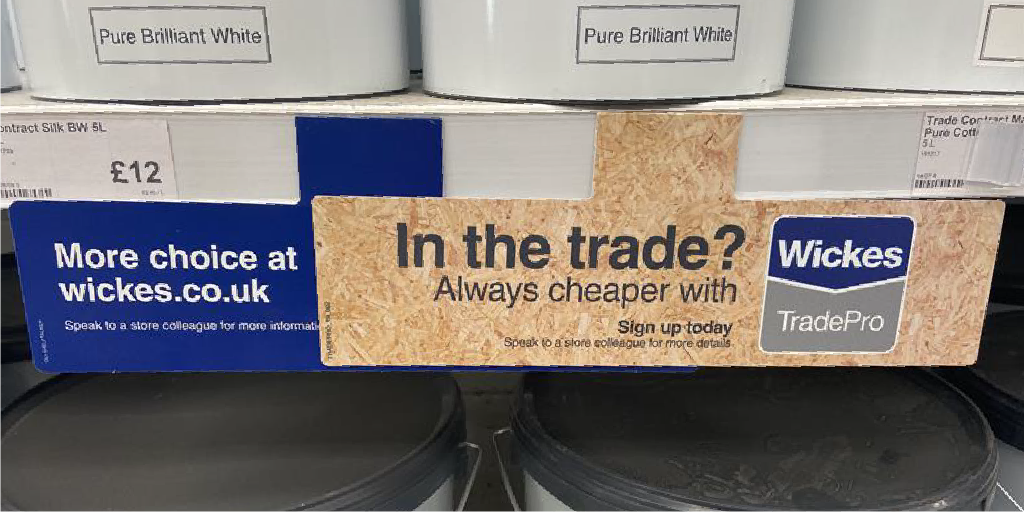Dual-purpose POS strategies
Balancing both audiences.
Trade account customers expect a retail experience that emphasises bulk pricing, product reliability, familiarity and efficiency. While independent customers will often prioritise different aspects, such as product information and practical demonstrations.
The true test of a POS strategy in trade retail lies in balancing these two demands so that every customer, regardless of their background, feels at ease and welcomed in the store.
Trade account customers.

Trade retailers traditionally cater to customers with trade accounts who will usually be looking for bulk purchasing, loyalty-based discounts, robust product performance and time-saving in-store navigation.
Trade account customers will be looking for a store environment that respects their time, gives them efficient shopping options and showcases product durability and reliability. They’re likely to be more mission-focused, valuing POS displays that highlight functional benefits, promotions or trade discounts with a straightforward layout. POS strategies that streamline their shopping experience are essential.
Independent customers.

On the other hand, independent customers who visit less frequently will enter the same store hoping for a different experience. These customers may need more guidance, detailed product explanations and relatable messaging that speaks to their specific project or occasional needs.
For independent customers, POS displays are most likely to be effective when they offer clear, accessible information. Inspiring through visuals and storytelling, as well as providing practical insights or demonstrations will help this second audience feel confident in their choices.
Creating an inclusive in-store experience.
A major pitfall in trade retail is the tendency to design spaces and displays that heavily prioritise account customers, which can the independent purchasers feel lost or even intimidated.
A dual-purpose POS strategy requires a nuanced approach to visual merchandising that can resonate with both audiences, ensuring neither group feels overlooked. To build an environment where both audience types feel at home, trade retailers need to make deliberate choices about how POS displays are designed and located.
In this blog, we’re sharing five great ideas for printed point of sale materials which offer an entry-level in-store experience for those that need it, whilst ensuring trade account customers aren’t slowed down by information that’s irrelevant to them:
1. Welcoming ambience
The simplicity of printed POS materials to support a welcoming environment is easy to overlook.
Well-organised spaces, a clear trade counter and clearly marked sections using aisle fins, floor decals, floor mats and hanging signage all go a long way in helping customers feel at ease in a store.
2. Clear navigation
Navigation is important every step of the way, but even more so for customers who visit the store infrequently. Clear printed POS signage and segmentation ensure every customer feels confident in navigating the space.
Trade retailers can organise store layouts in a way that clearly signals where each type of customer can find what they need. For instance, areas with a strong focus on quick, repeat purchases cater best to trade account customers, while sections with detailed, step-by-step demonstrations or DIY-friendly kits will appeal to independent shoppers.
3. Layered information
Printed POS displays can easily be designed to offer multiple layers of information, allowing both account and independent customers to engage at their comfort level.
For example, a product sign might first show basic features and benefits that would appeal to account customers in need of a brief explanation, with further details available for those who want to learn more. Providing QR codes or quick links for digital information is a good way to enable specific customers to dive deeper without cluttering the main display.
4. Relatable storytelling
Relatable storytelling, coupled with easy-to-access product information, can be a great way to encourage a purchase from an independent customer.
Visuals showing products in real-life settings or projects. Displays featuring images of projects. Customer testimonials. Short narratives on how a product can solve common problems. There are lots of easy ways to use printed POS bring products to life for an audience less familiar with your inventory.
5. Fostering long-term loyalty
Ultimately, a POS strategy that effectively engages customers will bring value beyond individual sales. An inclusive, dual-purpose POS strategy will foster long-term loyalty across a diverse customer base.
When all customers feel welcomed and included in a store that’s primarily focused on serving trade accounts, they’re more likely to return, recommend the store, build loyalty… ultimately, perhaps, setting up as a new trade account.
Trade retailers who commit to refining their POS approach, making their spaces accessible and welcoming to all, will be well-equipped to create a positive, versatile in-store experience that accommodates every type of shopper.
Here at Summit Creative, we support our clients to balance, multi-purpose POS strategies that deliver an enhanced experience for all types of audiences. If you’re looking for a creative agency to help with your printed POS, get in touch.

Written by: Tina Brown.
Connect with me on LinkedIn.
